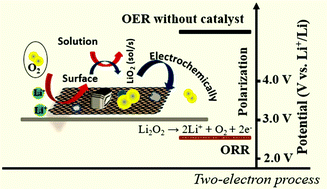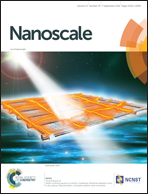Pyridinic-N-dominated carbon frameworks with porous tungsten trioxide nano-lamellae as a promising bi-functional catalyst for Li–oxygen batteries†
Abstract
The rational design and synthetic route to fabricate hybrid materials with desirable electrocatalytic functionalities remain critical but still challenging for sustainable energy devices. Here, we constructed a tungsten trioxide nano-lamellae chemically anchored with pyridinic-N-dominated doped CNT/graphene frameworks (W-NCG) via a general solution-based synthesis method. The detailed results indicated that this hybrid structure is composed of vacancy-defect abundant WO3 porous nanoflakes anchoring through or onto a 3D N-doped carbon matrix. After a facile post-annealing treatment, the W-NCG sample is utilized as a bi-functional catalyst for rechargeable lithium–oxygen batteries. The optimized sample with a large BET surface exhibits unprecedented ORR/OER activity in the cell, and satisfying specific capacity (∼7850 mA h g−1) and cycling stability. This excellent electrochemical performance can be ascribed to the pseudo 3D structure with sufficient microspace and good electrical conductivity, which facilitate the high dispersion of active components and effectivly relieve the formation of large/irreversible Li2O2. As such, this porous W-NCG framework is a prospective high-performance cathode material for Li–O2 batteries.



 Please wait while we load your content...
Please wait while we load your content...